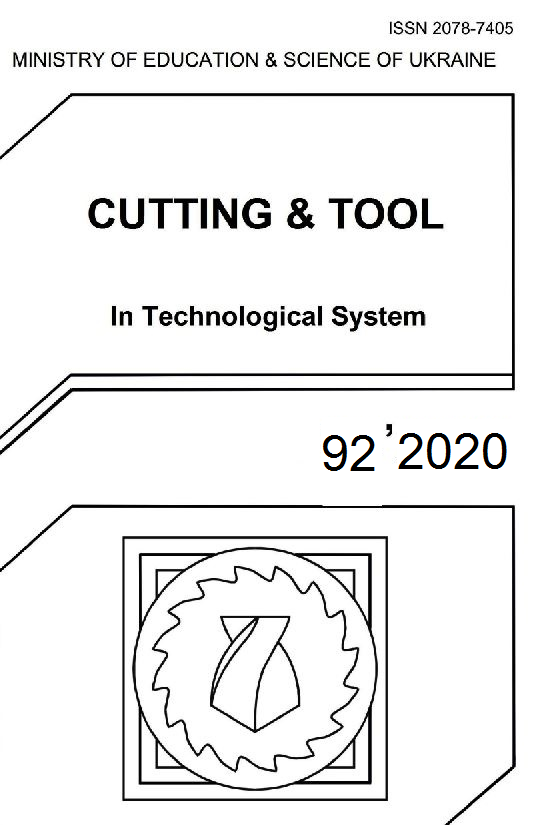THE INFLUENCE OF COOLING CONDUCTIVITY ON THE CHANGE OF TEMPERATURE GRADIENT IN THE PCBN TOOL
DOI:
https://doi.org/10.20998/2078-7405.2020.92.06Keywords:
thermal field, superhard composite, protective coating, thermo protective effect, cutting tool.Abstract
A model analysis of the effect of thermal conductivity of the TiAlN protective coating on the temperature gradient in a tool equipped with a super-rigid kiborite composite was performed in the processing of hardened steel. The finite element method solved a two-dimensional linear non-stationary problem of thermal conductivity with boundary conditions of the 3rd kind. At the control points on the support part of the tool as the limit conditions to take the temperatures determined when turning hardened steel with a cutting speed of 1.3 m/s. Given the presence of a gradient of material velocities, the chip model is divided into layers with different speeds. The amount of shrinkage of the chips is taken 2, which corresponds to the chip speed vc = 0.65 m/s. The movement of the chips along the contact surface of the tool was simulated taking into account the mass transfer in the region where the elements were specified. It is shown that increasing the cutting speed leads to a decrease in the temperature gradient in the tool, which is associated with a decrease in the friction coefficient, as well as the cutting force. The magnitude of the temperature drop in the coating depends on its thermal conductivity and the maximum temperature on the contact surface of the tool. It was found that the protective coating has a significant effect on the temperature gradient in the cutting tool of the superhard PcBN composite in the case when its coefficient of thermal conductivity of the coating does not exceed 15 W/mK. Such coatings cause a decrease in the surface temperature of the section of the system «basis of PcBN coating» when turning hardened steel at 100–300 °C. If the coefficient of thermal conductivity of the coating is higher than 15 W/mK, it has a minimal effect on the temperature on the surface of the section of the system «basis of PcBN coating», despite the fact that the value of thermal conductivity of the composite PcBN much more.References
Novikov N. V., Klimenko S. A. Instrumental’noe obespechenie progressa mehanoobrobotki v mashinostroenii. Tehnologicheskie sustemy, 2010, no. 1(50), pp. 69–74;
Coelho R. T., Ng E.-G., Elbestawi M. A. Tool wear when turning hardened AISI 4340 with coated PCBN tools using finishing cutting conditions. Inter. J. of Machine Tools and Manufacture, 2007, 47(2), рр. 263–272;
Rech J., Kusiak A., Battaglia J. L. Tribological and thermal functions of cutting tool coatings. Surf. and Coat. Technol., 2004, 186(3), рр. 364–371;
Verestchaka А. S., Verestchaka А. А. Nekotorye metodologicheskie printcipy sozdanija funktsional’nyh pokrytii dlja rezhutschego instrumenta. Suchasni tehnologii v mashinibuduvanni. Kharkiv, 2010, vyp. 4, рр. 97–122;
Novikov N.V., Klimenko S.A. (eds.). Instrumenty iz sverhtverdyh materialov. – Moskow, Mashinostroyeniye Publ., 2014, 608 p.;
Klimenko S. A. (ed.). Vysokoproizvoditel'naya chistovaya lezviynaya obrabotka detaley iz staley vysokoy tverdosti. – Kyiv, ISM im. V. N. Bakulya NAN Ukrainy Publ., 2018, 304 p.
Downloads
Published
Issue
Section
License
Copyright Notice
Authors who publish with this Collection agree to the following terms:
1. Authors retain copyright and grant the Collection right of first publication with the work simultaneously licensed under a Creative Commons Attribution License that allows others to share the work with an acknowledgement of the work's authorship and initial publication in this Collection.
2. Authors are able to enter into separate, additional contractual arrangements for the non-exclusive distribution of the Collection's published version of the work (e.g., post it to an institutional repository or publish it in a book), with an acknowledgement of its initial publication in this Collection.
3. Authors are permitted and encouraged to post their work online (e.g., in institutional repositories or on their website) prior to and during the submission process, as it can lead to productive exchanges, as well as earlier and greater citation of published work.

